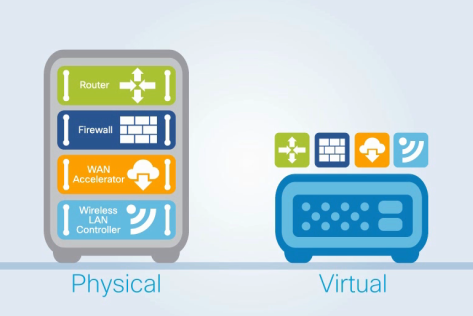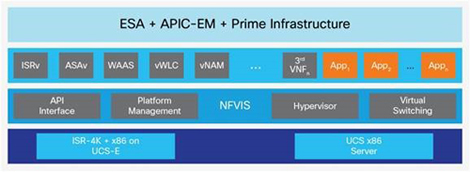Programs become more important than iron

After reading the news about staff reductions at Cisco, I decided to phone my good friend, who has been working for more than a year for the benefit of this network equipment manufacturer. A friend confirmed that they were really going to fire some of the employees. True, he voiced a more modest figure than the one that appeared in the article of one Russian Internet publication.
This is not the first reduction. And as it was in past years, the main reason is the reorientation of the company to software development. He himself moved to another department, where he is now engaged in supporting cloud products.
At the new place of work, the python became the best friend of my acquaintance, like many other network engineers. Not one that creeps, but one that is a programming language. Python is in demand for all kinds of projects to improve internal systems, procedures and automation in the company. In general, this programming language has often appeared in various documents, presentations and solutions of the vendor. For example, support for this programming language has appeared in Nexus switches. In general, to enable users to create the necessary logic for the behavior of network equipment themselves is correct. At this rate, we will soon have to write various programs at Cisco courses. And instead of show run we will output Hello world.
Having exchanged a few words about the main trends, it turned out that everyone was completely busy with thoughts about neural networks, Big Data, machine learning and other transcendental technologies. This is probably correct. After all, it’s difficult to make switches, routers, access points more revolutionary. But while there is a persistent feeling that these sky-high solutions are not a bit about us. Anyway, at the moment. Although in terms of the same security, Cisco already offers cloud-based security solutions based on implementations similar to artificial intelligence.
The future is around
My friend’s new department is fun enough. Next door are the guys working in the field of IoT (Internet of Things - Internet of Things). The cases they do are constantly attracting attention. And where else can you hear about how the cow does not respond. Yes, it’s a cow. And she does not respond! LoRaWAN transmitters were hung on all cattle. And one of the cows has a problem. Sadness, of course. But the guys are great, and I'm sure they help such poor animals. Otherwise, milk stress may suffer from such stress. Which, in turn, will adversely affect our entire agriculture.
The production of software products is becoming more interesting for business than hardware solutions. Firstly, it is no secret that iron sales are slowly falling. This is also affected by clouds, the transition to which leads to the fact that the company's own infrastructure, moving to the clouds, becomes poorer. And serious competition, which does not go anywhere, but only intensifies, fueled by the constant entry of new companies into the market. And at the same time, iron becomes relatively standard (sometimes it seems to me that many products of different manufacturers are produced at the same Foxconn plant), competition is only growing.
Secondly, in terms of finance, software production seems more profitable than hardware. There is no need to solve problems with the construction of plants and their maintenance, balances in warehouses, components, defective equipment, etc. Selling licenses is a more pleasant and marginal task. Indeed, in this case, practically air is sold. True, if this air is constantly shutting down, it becomes costly to maintain it.
If we are talking about products that have traditionally been software, a deeper reorientation to them does not raise any questions. The same can be said for software-defined networks (SDNs). This concept opens up vast expanses for creating new software solutions that are closely related to network equipment. The scope of SDN is huge. Starting from the automation of routine network equipment configuration processes. And ending with the management of all elements of the IT infrastructure in order to automate various processes and receive completely new services.
But what about the switches, routers and other devices that we are used to seeing in the iron version? This is where virtualization technology comes to the fore. The recipe is relatively simple: we virtualize network services and move away from the iron part. If we look at Cisco, we will notice that the vendor has been along this path for quite some time. There is a systematic transition from the uplining scheme to the virtual machine scheme on something. Of course, ideal for Cisco if it is a UCS server. But if not him, then the vendor, it seems to me, will not be very offended.
At the moment, in the Cisco product line, we see that many solutions are offered as virtual implementations. Modern processors, coupled with support for optimized processing of network traffic, allow you to implement many solutions without resorting to using specialized hardware (ASICs, network processors, etc.). We partially mentioned this in the CBS blog about control and data plane in network equipment .
Now in the form of a virtual solution we can get a router (for example, Cisco ISRv), a firewall (for example, Cisco ASAv), a wireless network controller (for example, Cisco vWLC) and other solutions. Similar solutions are offered by other market players: Juniper, Huawei, etc. And since in most cases we have Ethernet at the input, all these solutions can be run on the basis of a regular server.

All of this comes together under the umbrella of the Network Functions Virtualization (NFV) architecture. It is worth noting that service virtualization allows you to significantly move both towards the clouds and SDN. The automatic deployment of services here and now seems to be a simpler task when these services are virtualized. Therefore, for data centers, NFV solutions are extremely interesting. But the enterprise is slowly pulling up. We are already used to something in virtual performance. To something else not. For example, we still want to see a router or a firewall in our office as a separate box. It seems both more reliable and safer. But the market moves us further by offering fully virtualized office solutions. For example, Cisco supplementing NFV solutions with orchestration tools, monitoring and hardware resources (here the vendor does not want to get rid of the hardware itself), offers the Enterprise NFV architecture. Its main components are:
- Enterprise Service Automation (ESA) orchestration solution based on APIC-EM (SDN controller) and Prime Infrastructure monitoring;
- various NFV solutions;
- software on the basis of which all services are launched: a Linux-based hypervisor with additional monitoring, switching tools, etc .;
- hardware resources: UCS or UCS-E server.

Enterprise NFV should allow to reduce the time of implementation of various services in the office of the company, making the process as automated as possible. Somewhere I already heard it. In my opinion, this approach does not seem too vital. Although time will tell. Anyway, but the motion vector is set.
With most network devices, everything is clear. But what about the usual iron switches? It’s more difficult with them. Still, patch cords need to be connected somewhere, and obviously the server is not very suitable for this. But there are products on the market that allow you to separate software from hardware. These are the so-called bare metal switches. Such a switch goes without an operating system that the user selects and installs on his own. HPE, Edgecore, Dell, etc. have such solutions.
Nowadays, you can calmly concentrate on developing software solutions without significantly losing your presence in various market segments. Undoubtedly, the production of specialized iron solutions, where the software is practically separable from the hardware, will continue as long as the market is interested in this. These are powerful cabinets and lockers to handle a huge amount of traffic. And, for example, wireless access points. Although no, access points are an interesting question. If you look at the hardware of these devices, you can see that many of them are built on the Broadcom chipset. By and large, only the software and the device case change.
Thus, there is a tendency that many solutions can be offered to the market in isolation from the iron component. As an engineer, I like this opportunity, as it allows me to test almost any solution, without buying expensive equipment.
